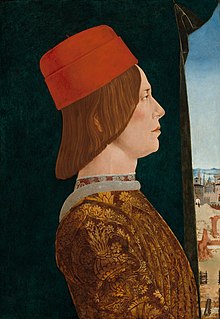Giovanni II Bentivoglio

Giovanni II Bentivoglio (12 February 1443 – 15 February 1508) was an Italian nobleman who ruled as
Background
Born in Bologna, Giovanni II was the son of Annibale I Bentivoglio, then chief magistrate of the commune, and Donnina Visconti. He was a child when his father was murdered by his rival Battista Canneschi in June 1445.
Annibale I was succeeded in Bologna by
Ruler of Bologna
In order to secure the support of the other powerful families of Italy, Giovanni fought personally as condottiero. In 1467 he was at the service of Florence, Milan and Naples against Bartolomeo Colleoni, and in 1471 again for Milan, but his first military deeds occurred only in 1477 when he besieged Faenza for the Sforza. In 1482, during the War of Ferrara, he helped Ercole d'Este against Pope Sixtus IV and Venice. He later fought in small struggles for the Kingdom of Naples, but his personal interventions were always limited by the Bolognese institutions.
In 1488, his daughter Francesca poisoned her own husband,
Bentivoglio had managed to resist the expansionist designs of
Giovanni moved first to
Excommunicated, Giovanni ended his days as prisoner of Louis XII in Milan. He died in 1508 in the Castello Sforzesco of that city.
Giovanni Bentivoglio is said to have consulted in 1504 the famous astrologer Luca Gaurico about his and his sons' destiny. Displeased with Gaurico's negative prophecy, Bentivoglio subjected him to the torture of mancuerda, and exiled him from Bologna.
Overview
Giovanni II Bentivoglio ruled with a stern sway for nearly half a century,[1] maintaining a splendid court and beautifying Bologna, in particular developing its waterways. The misery of the city's poor, however, stood in stark contrast to the splendor of the city and its festivities.
Among the projects he commissioned were the frescoes depicting the life of
Family and descendants
On 2 May 1464 Giovanni married Ginevra Sforza (1440–1507), the illegitimate daughter of Alessandro Sforza, Lord of Pesaro and the widow of his cousin and predecessor, Sante Bentivoglio. [2]There was probably a relationship between them before their marriage.[3] She was, among other things, his counselor. Ginevra gave her husband sixteen children, of whom five died in infancy. The others were:

- Annibale II Bentivoglio (1469–1540) who married Lucrezia, daughter of Ercole I d'Este, and who was lord of Bologna from 1511 to 1512;
- Ermes Bentivoglio (1475–1513)
- Alessandro Bentivoglio (1474–1532), who married Ippolita Sforza;
- Camilla, a nun at Corpus Christi
- Isotta, a nun at Corpus Christi
- Francesca, married to Galeotto Manfredi
- Antongaleazzo Bentivoglio, prelate
- Eleonora
- Laura, wife of Giovanni Gonzaga
- Violante, wife of Pandolfo IV Malatesta
- Bianca.
Giovanni also had another daughter (whether illegitimate or not, it is unknown), Camilla Bentivoglio, whose mother is said to be a 'Lucrezia D'Este'. Whether this 'Lucrezia' was the same as his daughter-in-law, daughter of
- Isabel Gonzaga, who married Rodolfo Gonzaga, her cousin and, like her, a great-grandchild of Ludovico III Gonzaga
- Carlos Gonzaga
- Lucrezia Gonzaga, a pupil of Matteo Bandello
Through Isabel and Carlos, Camilla and her father Giovanni are ancestors of Henri, Grand Duke of Luxembourg and his first cousin, King Philippe of Belgium.
Sources
- Ady, Cecilia M. (1937). The Bentivoglio of Bologna: A Study in Despotism. London: Oxford University Press.
- "Ginevra e Gentile". Accademia Culturale "Castelli in Aria" (in Italian).
- Clarke, Georgia (1999). "Magnificence and the City: Giovanni II Bentivoglio and Architecture in Fifteenth-Century Bologna". Renaissance Studies. 13 (4): 397–411. .
- Rendina, Claudio (1998). I capitani di ventura. Rome: Newton Compton.
- Samoggia, Sandro (2013). "Giovanni II, il Principe di Bologna". Mia Bologna.
References
- ^ a b One or more of the preceding sentences incorporates text from a publication now in the public domain: Chisholm, Hugh, ed. (1911). "Bentivoglio, Giovanni". Encyclopædia Britannica. Vol. 3 (11th ed.). Cambridge University Press. pp. 749–750. This also cites:
- P. Litta, Le Famiglie celebri Italiane, vol. iii. (Milan, 1834)
- P. Villari, Machiavelli (Eng. trans., London, 1892)
- M. Creighton, History of the Papacy (London, 1897)
- A. von Reumont, Geschichte der Stadt Rom, vol iii. (Berlin, 1868).
- ^ Ginevra e Gentile.
- ^ Samoggia 2013.
External links
- Ginevra Sforza Archived 2013-07-23 at the Wayback Machine
- Machiavelli's The Prince (Online Text)
